Nitrogen-Doped Carbon-Coating Disproportionated SiO Materials as Long Cycling Stable Anode for Lithium Ion Batteries
Abstract
1. Introduction
2. Results and Discussion
2.1. Materials Preparation
2.2. Materials Morphology
2.3. Electrochemical Performance in Half Cells
2.4. CV and EIS Test and the Calculation of Chemical Diffusion Coefficient
2.5. Pre-Lithiate d-SiO-NC Anode and Full Cell Test
3. Materials and Methods
3.1. Material Synthesis
3.2. Material Characterization
3.3. Preparation of Electrode
3.4. The Fabrication of Cells
3.5. Electrochemical Test of Cells
4. Conclusions
Author Contributions
Funding
Institutional Review Board Statement
Informed Consent Statement
Data Availability Statement
Acknowledgments
Conflicts of Interest
Sample Availability
References
- Armstrong, G. The Li-ions share. Nat. Chem. 2019, 11, 1076. [Google Scholar] [CrossRef] [PubMed]
- Zeng, X.; Li, M.; Abd El-Hady, D.; Alshitari, W.; Al-Bogami, A.S.; Lu, J.; Amine, K. Commercialization of Lithium Battery Technologies for Electric Vehicles. Adv. Energy Mater. 2019, 9, 1900161. [Google Scholar] [CrossRef]
- Schmuch, R.; Wagner, R.; Hörpel, G.; Placke, T.; Winter, M. Performance and cost of materials for lithium-based rechargeable automotive batteries. Nat. Energy 2018, 3, 267–278. [Google Scholar] [CrossRef]
- Chu, B.; Liu, S.; You, L.; Liu, D.; Huang, T.; Li, Y.; Yu, A. Enhancing the Cycling Stability of Ni-Rich LiNi0.6Co0.2MO2 Cathode at a High Cutoff Voltage with Ta Doping. ACS Sustain. Chem. Eng. 2020, 8, 3082–3090. [Google Scholar] [CrossRef]
- Liu, D.; Liu, S.; Zhang, C.; You, L.; Huang, T.; Yu, A. Revealing the Effect of Ti Doping on Significantly Enhancing Cyclic Performance at a High Cutoff Voltage for Ni-Rich LiNi0.8Co0.15Al0.05O2 Cathode. ACS Sustain. Chem. Eng. 2019, 7, 10661–10669. [Google Scholar] [CrossRef]
- Liu, S.; Wang, L.; Zhang, C.; Chu, B.; Wang, C.; Huang, T.; Yu, A. Dynamic evolution of Cathode−Electrolyte interface of LiNi0.6Co0.2Mn0.2O2 during the initial Charge−Discharge process. J. Power Sources 2019, 438, 226979. [Google Scholar] [CrossRef]
- Chen, H.; Xiao, Y.; Wang, L.; Yang, Y. Silicon nanowires coated with copper layer as anode materials for lithium-ion batteries. J. Power Sources 2011, 196, 6657–6662. [Google Scholar] [CrossRef]
- Ruttert, M.; Siozios, V.; Winter, M.; Placke, T. Mechanochemical Synthesis of Fe–Si-Based Anode Materials for High-Energy Lithium Ion Full-Cells. ACS Appl. Energy Mater. 2020, 3, 743–758. [Google Scholar] [CrossRef]
- Müller, J.; Abdollahifar, M.; Vinograd, A.; Nöske, M.; Nowak, C.; Chang, S.-J.; Placke, T.; Haselrieder, W.; Winter, M.; Kwade, A.; et al. Engineering Si-on-Graphite High-Capacity Anodes for Li-ion Battery Applications Fabricated by Fluidized Bed Process. Chem. Eng. J. 2020, 407, 126603. [Google Scholar] [CrossRef]
- Boukamp, B.A.; Lesh, G.C.; Huggins, R.A. All-Solid Lithium Electrodes with Mixed-Conductor Matrix. J. Electrochem. Soc. 1981, 128, 725–729. [Google Scholar] [CrossRef]
- Liang, B.; Liu, Y.; Xu, Y. Silicon-based materials as high capacity anodes for next generation lithium ion batteries. J. Power Sources 2014, 267, 469–490. [Google Scholar] [CrossRef]
- Li, J.-Y.; Xu, Q.; Li, G.; Yin, Y.-X.; Wan, L.-J.; Guo, Y.-G. Research progress regarding Si-based anode materials towards practical application in high energy density Li-ion batteries. Mater. Chem. Front. 2017, 1, 1691–1708. [Google Scholar] [CrossRef]
- Zuo, X.; Zhu, J.; Müller-Buschbaum, P.; Cheng, Y.-J. Silicon based lithium-ion battery anodes: A chronicle perspective review. Nano Energy 2017, 31, 113–143. [Google Scholar] [CrossRef]
- Wu, H.; Cui, Y. Designing nanostructured Si anodes for high energy lithium ion batteries. Nano Today 2012, 7, 414–429. [Google Scholar] [CrossRef]
- Ashuri, M.; He, Q.; Shaw, L.L. Silicon as a potential anode material for Li-ion batteries: Where size, geometry and structure matter. Nanoscale 2016, 8, 74–103. [Google Scholar] [CrossRef] [PubMed]
- Holzapfel, M.; Buqa, H.; Hardwick, L.J.; Hahn, M.; Würsig, A.; Scheifele, W.; Novák, P.; Kötz, R.; Veit, C.; Petrat, F.-M. Nano silicon for lithium-ion batteries. Electrochim. Acta 2006, 52, 973–978. [Google Scholar] [CrossRef]
- Beaulieu, L.Y.; Eberman, K.W.; Turner, R.L.; Krause, L.J.; Dahn, J.R. Colossal Reversible Volume Changes in Lithium Alloys. Electrochem. Solid State Lett. 2001, 4, A137–A140. [Google Scholar] [CrossRef]
- Liu, Z.; Yu, Q.; Zhao, Y.; He, R.; Xu, M.; Feng, S.; Li, S.; Zhou, L.; Mai, L. Silicon oxides: A promising family of anode materials for lithium-ion batteries. Chem. Soc. Rev. 2019, 48, 285–309. [Google Scholar] [CrossRef] [PubMed]
- Huang, B.; Huang, T.; Wan, L.; Yu, A. Pre-Lithiating SiO Anodes for Lithium-Ion Batteries by a Simple, Effective, and Controllable Strategy Using Stabilized Lithium Metal Powder. ACS Sustain. Chem. Eng. 2021, 9, 648–657. [Google Scholar] [CrossRef]
- Yu, B.-C.; Hwa, Y.; Kim, J.-H.; Sohn, H.-J. A New Approach to Synthesis of Porous SiOx Anode for Li-ion Batteries via Chemical Etching of Si Crystallites. Electrochim. Acta 2014, 117, 426–430. [Google Scholar] [CrossRef]
- Yu, B.-C.; Hwa, Y.; Park, C.-M.; Sohn, H.-J. Reaction mechanism and enhancement of cyclability of SiO anodes by surface etching with NaOH for Li-ion batteries. J. Mater. Chem. A 2013, 1, 4820–4825. [Google Scholar] [CrossRef]
- Hwa, Y.; Park, C.M.; Sohn, H.J. Modified SiO as a high performance anode for Li-ion batteries. J. Power Sources 2013, 222, 129–134. [Google Scholar] [CrossRef]
- Doh, C.-H.; Park, C.-W.; Shin, H.-M.; Kim, D.-H.; Chung, Y.-D.; Moon, S.-I.; Jin, B.-S.; Kim, H.-S.; Veluchamy, A. A new SiO/C anode composition for lithium-ion battery. J. Power Sources 2008, 179, 367–370. [Google Scholar] [CrossRef]
- Kim, J.-H.; Sohn, H.-J.; Kim, H.; Jeong, G.; Choi, W. Enhanced cycle performance of SiO-C composite anode for lithium-ion batteries. J. Power Sources 2007, 170, 456–459. [Google Scholar] [CrossRef]
- Morita, T.; Takami, N. Nano Si Cluster-SiOx-C Composite Material as High-Capacity Anode Material for Rechargeable Lithium Batteries. J. Electrochem. Soc. 2006, 153, A425–A430. [Google Scholar] [CrossRef]
- Yamada, M.; Ueda, A.; Matsumoto, K.; Ohzuku, T. Silicon-Based Negative Electrode for High-Capacity Lithium-Ion Batteries: “SiO”-Carbon Composite. J. Electrochem. Soc. 2011, 158, A417–A421. [Google Scholar] [CrossRef]
- Choi, I.; Lee, M.J.; Oh, S.M.; Kim, J.J. Fading mechanisms of carbon-coated and disproportionated Si/SiOx negative electrode (Si/SiOx/C) in Li-ion secondary batteries: Dynamics and component analysis by TEM. Electrochim. Acta 2012, 85, 369–376. [Google Scholar] [CrossRef]
- Kim, K.W.; Park, H.; Lee, J.G.; Kim, J.; Kim, Y.-U.; Ryu, J.H.; Kim, J.J.; Oh, S.M. Capacity variation of carbon-coated silicon monoxide negative electrode for lithium-ion batteries. Electrochim. Acta 2013, 103, 226–230. [Google Scholar] [CrossRef]
- Xing, Y.; Zhang, L.; Mao, S.; Wang, X.; Wenren, H.; Xia, X.; Gu, C.; Tu, J. Core-shell structure of porous silicon with nitrogen-doped carbon layer for lithium-ion batteries. Mater. Res. Bull. 2018, 108, 170–175. [Google Scholar] [CrossRef]
- Lee, D.J.; Ryou, M.-H.; Lee, J.-N.; Kim, B.G.; Lee, Y.M.; Kim, H.-W.; Kong, B.-S.; Park, J.-K.; Choi, J.W. Nitrogen-doped carbon coating for a high-performance SiO anode in lithium-ion batteries. Electrochem. Commun. 2013, 34, 98–101. [Google Scholar] [CrossRef]
- Park, C.-M.; Choi, W.; Hwa, Y.; Kim, J.-H.; Jeong, G.; Sohn, H.-J. Characterizations and electrochemical behaviors of disproportionated SiO and its composite for rechargeable Li-ion batteries. J. Mater. Chem. 2010, 20, 4854–4860. [Google Scholar] [CrossRef]
- Shen, T.; Xie, D.; Tang, W.; Wang, D.; Zhang, X.; Xia, X.; Wang, X.; Tu, J. Biomass-derived carbon/silicon three-dimensional hierarchical nanostructure as anode material for lithium ion batteries. Mater. Res. Bull. 2017, 96, 340–346. [Google Scholar] [CrossRef]
- Philippe, B.; Dedryvère, R.; Allouche, J.; Lindgren, F.; Gorgoi, M.; Rensmo, H.; Gonbeau, D.; Edström, K. Nanosilicon Electrodes for Lithium-Ion Batteries: Interfacial Mechanisms Studied by Hard and Soft X-ray Photoelectron Spectroscopy. Chem. Mater. 2012, 24, 1107–1115. [Google Scholar] [CrossRef]
- Miyachi, M.; Yamamoto, H.; Kawai, H.; Ohta, T.; Shirakata, M. Analysis of SiO Anodes for Lithium-Ion Batteries. J. Electrochem. Soc. 2005, 152, A2089–A2091. [Google Scholar] [CrossRef]
- Shen, T.; Xia, X.-H.; Xie, D.; Yao, Z.-J.; Zhong, Y.; Zhan, J.-Y.; Wang, D.-H.; Wu, J.-B.; Wang, X.-L.; Tu, J.-P. Encapsulating silicon nanoparticles into mesoporous carbon forming pomegranate-structured microspheres as a high-performance anode for lithium ion batteries. J. Mater. Chem. A 2017, 5, 11197–11203. [Google Scholar] [CrossRef]
- Teo, L.P.; Buraidah, M.H.; Arof, A.K. Study on Li+ ion diffusion in Li2SnO3 anode material by CV and EIS techniques. Mol. Cryst. Liq. Cryst. 2020, 694, 117–130. [Google Scholar] [CrossRef]
- Wang, H.; Xie, J.; Zhang, S.; Cao, G.; Zhao, X. Scalable preparation of silicon@graphite/carbon microspheres as high-performance lithium-ion battery anode materials. RSC Adv. 2016, 6, 69882–69888. [Google Scholar] [CrossRef]
- Bard, A.J.; Faijlkner, L.R. Electrochemical Methods Fundamentals and Applications, 2nd ed.; John Wiley & Sons, Inc.: Hoboken, NJ, USA, 2001. [Google Scholar]
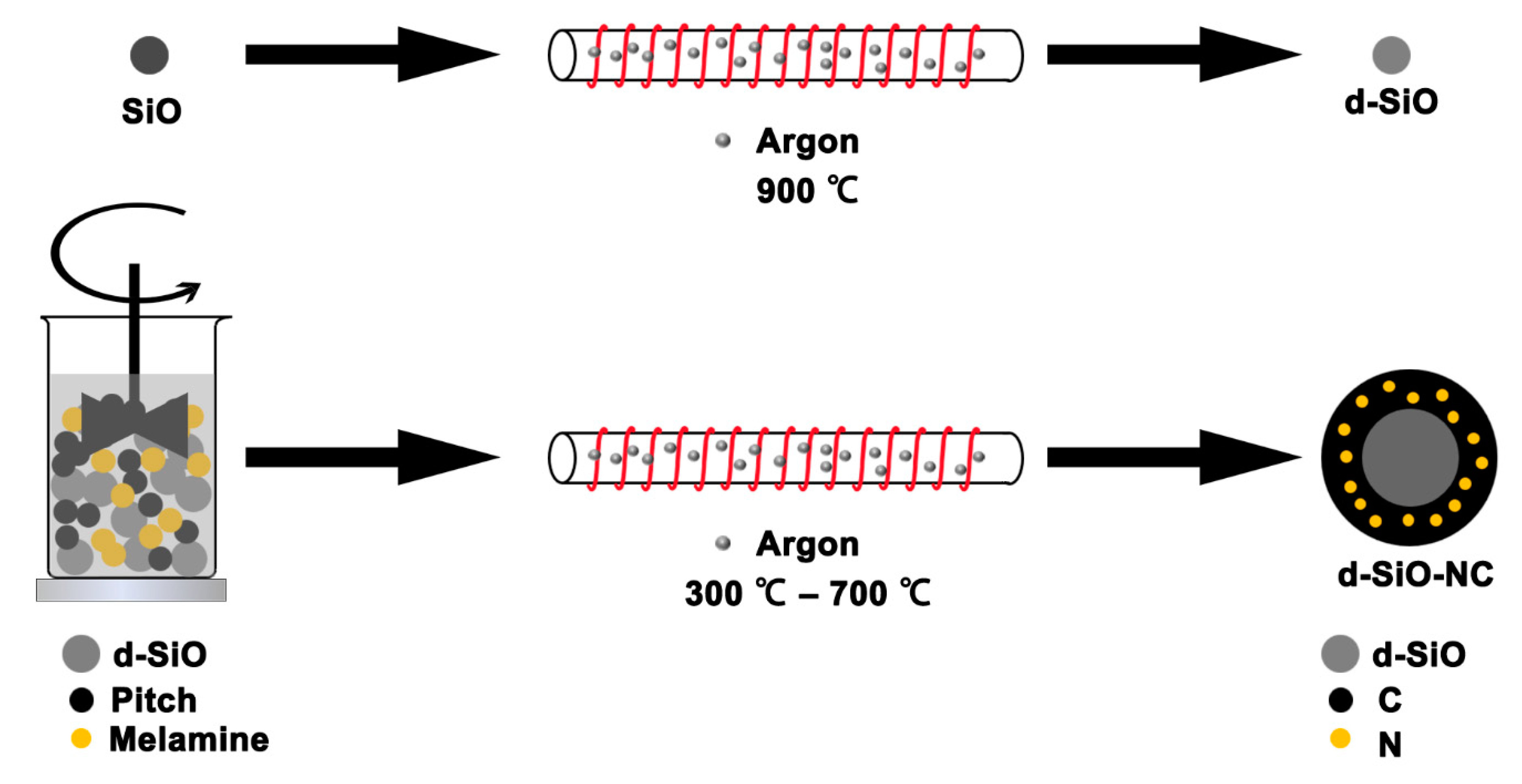
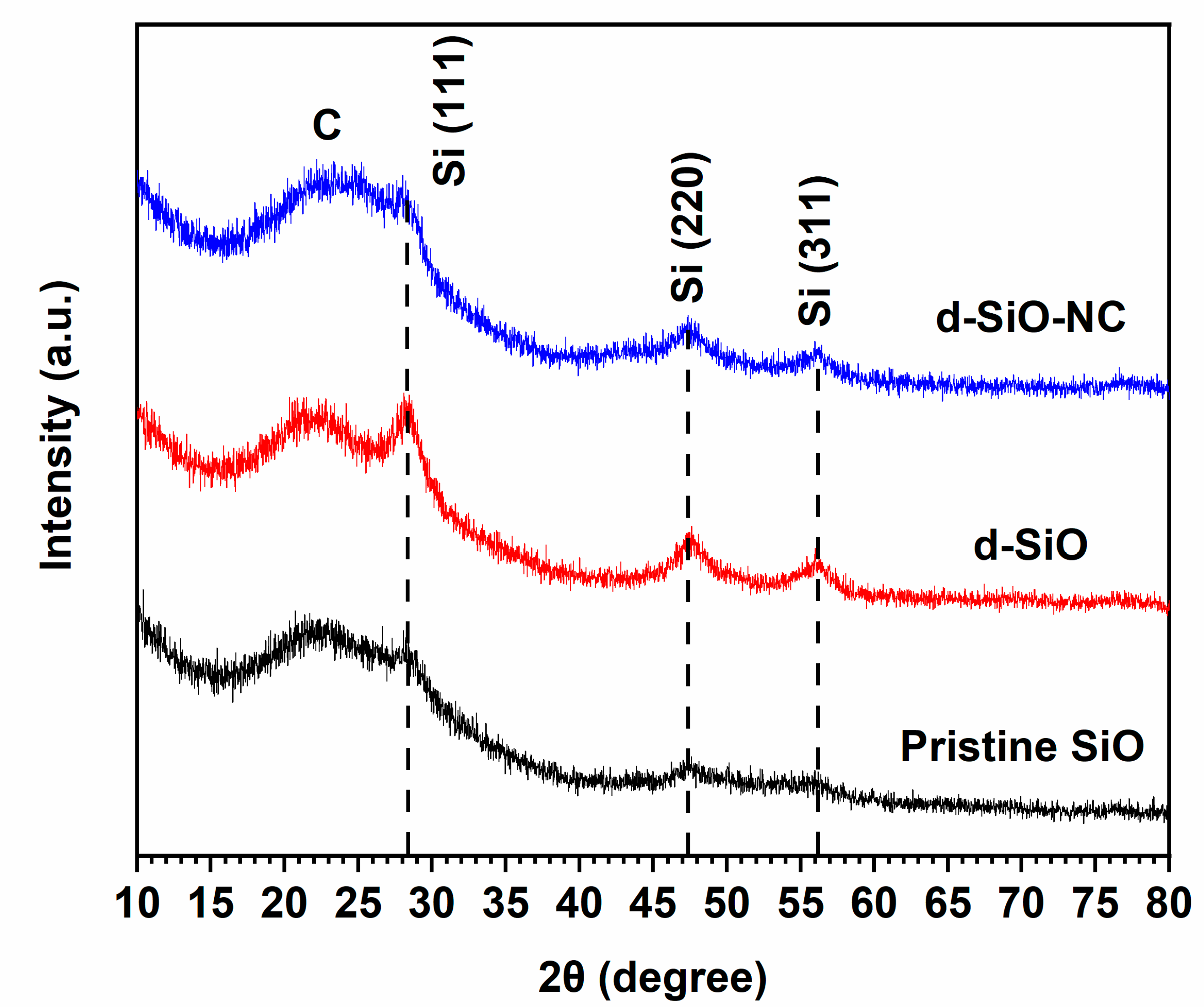
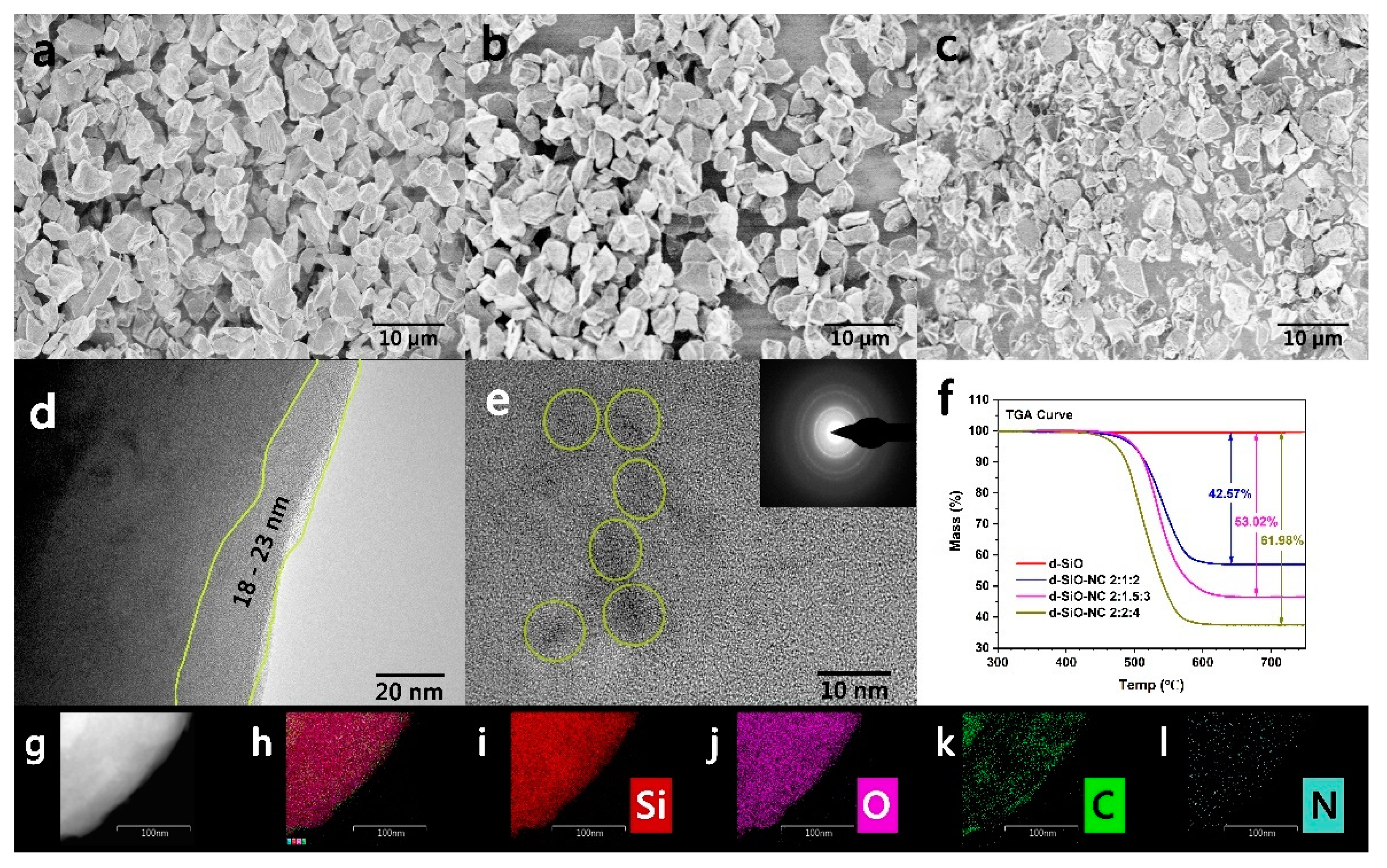
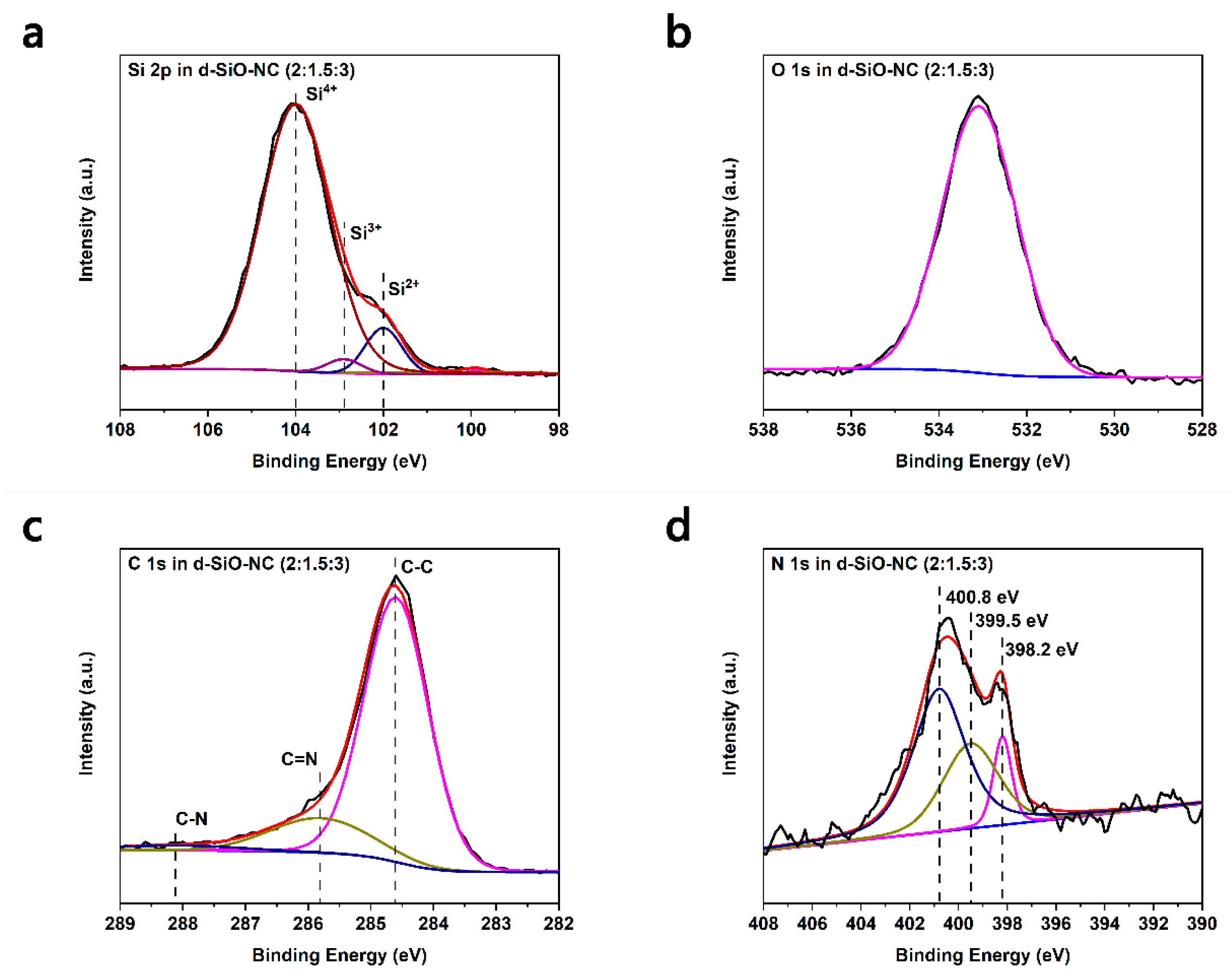
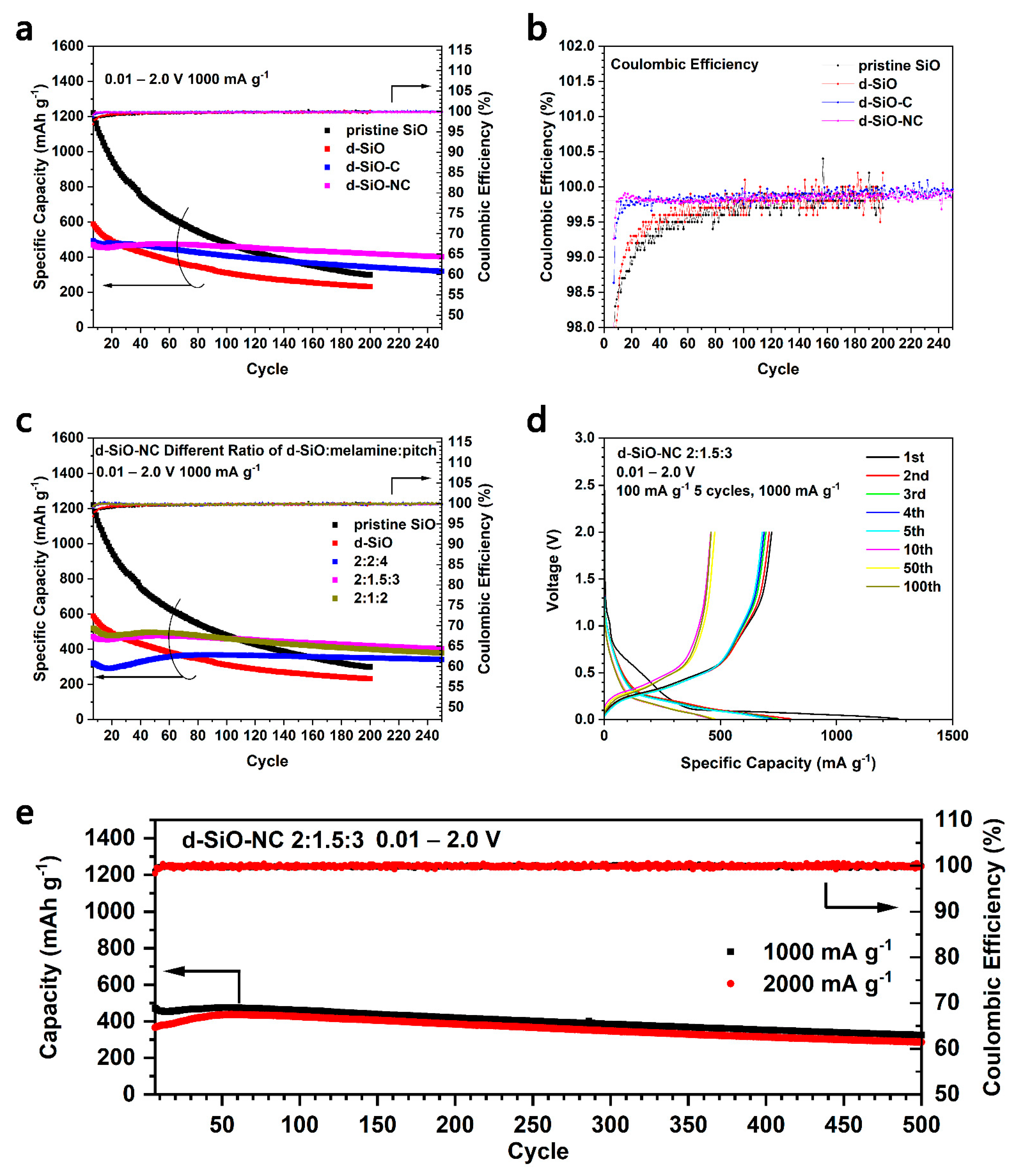
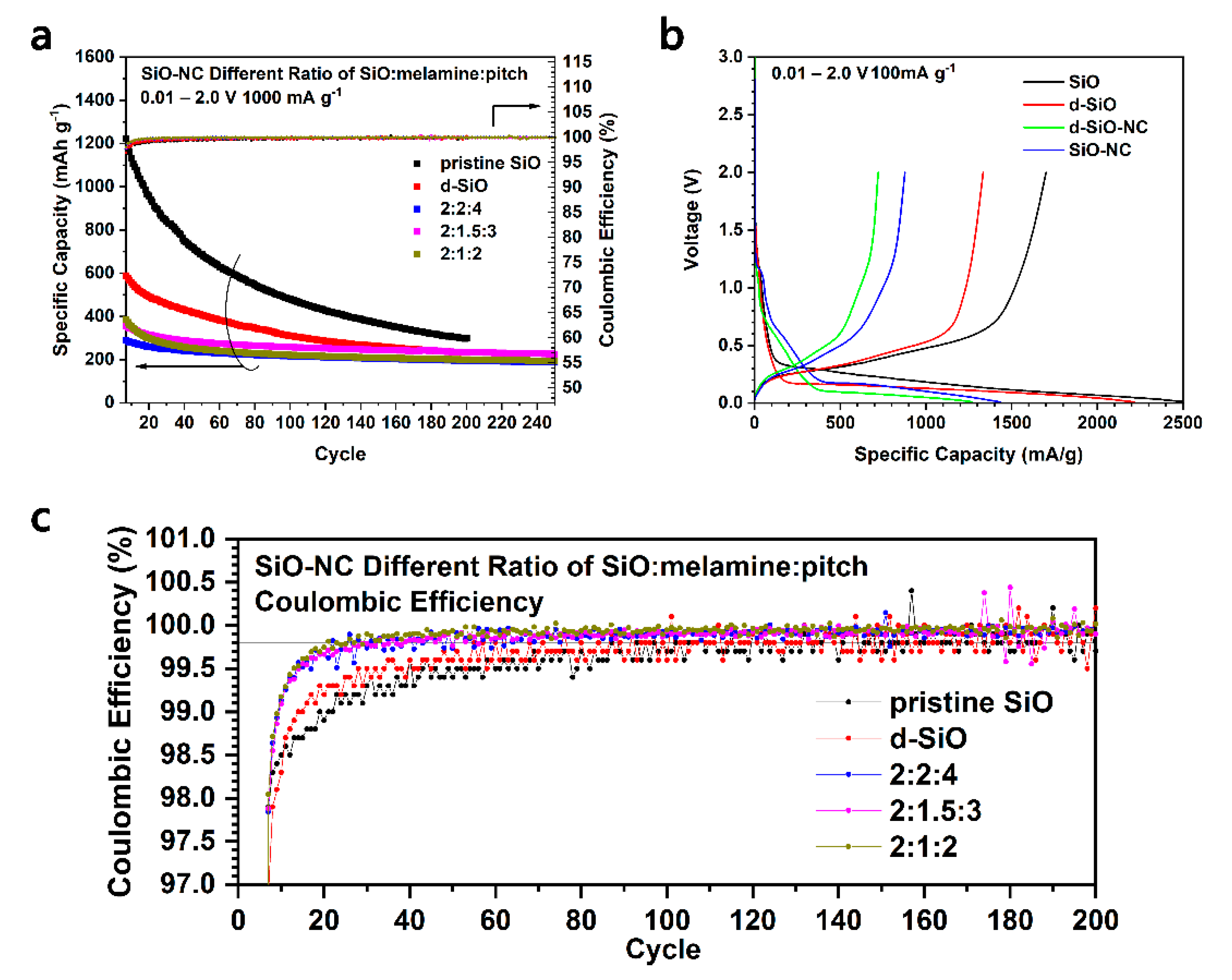
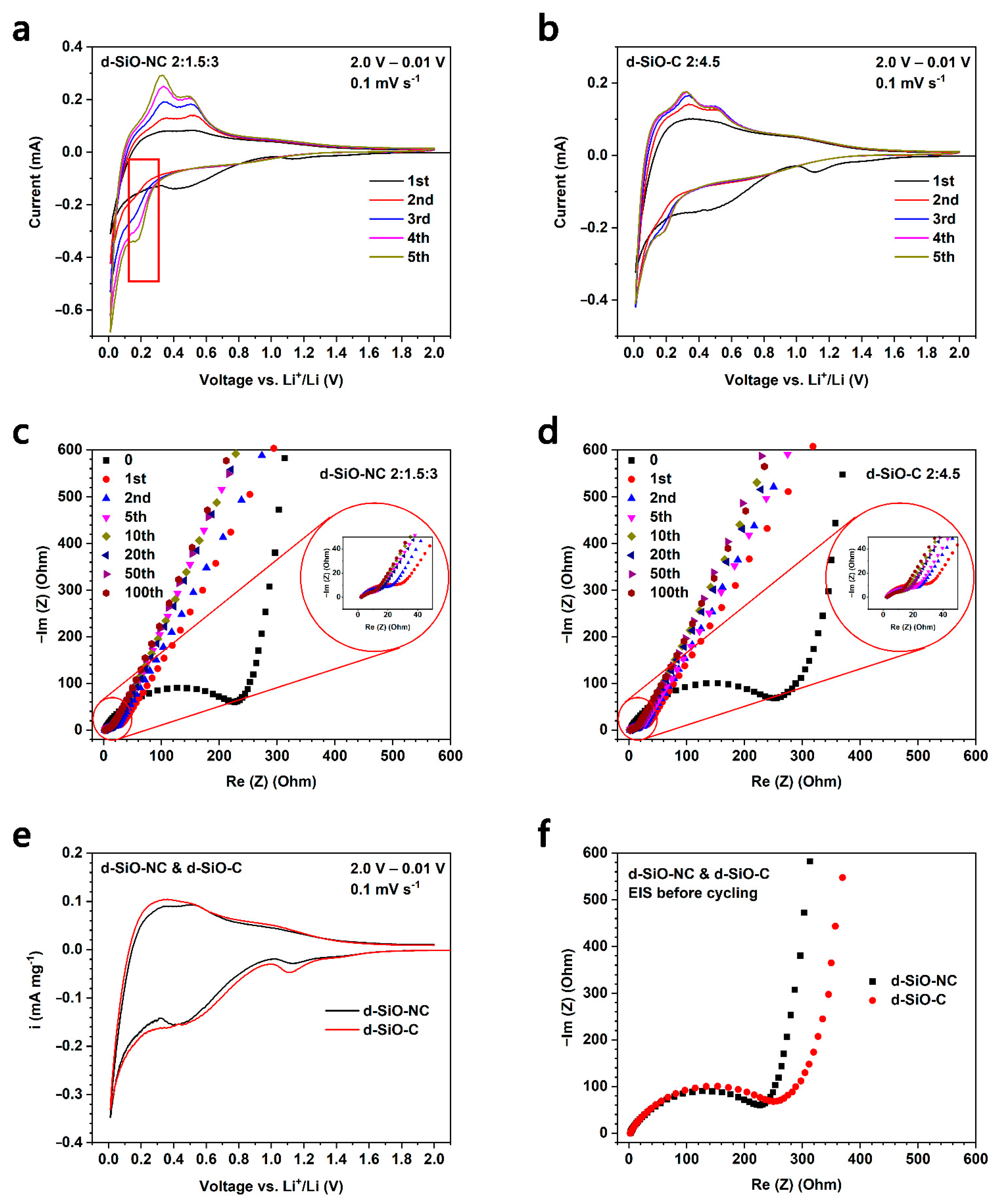
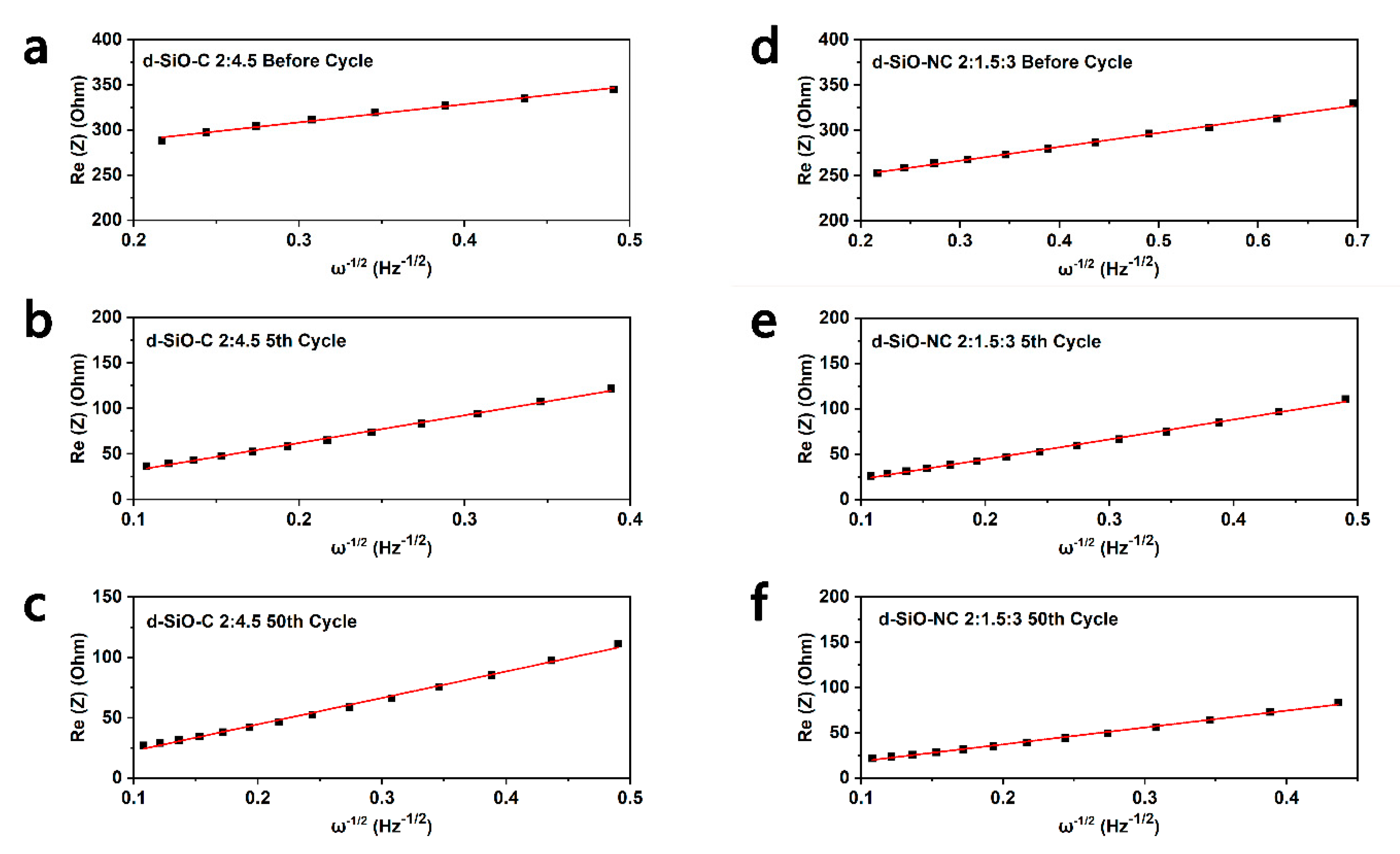
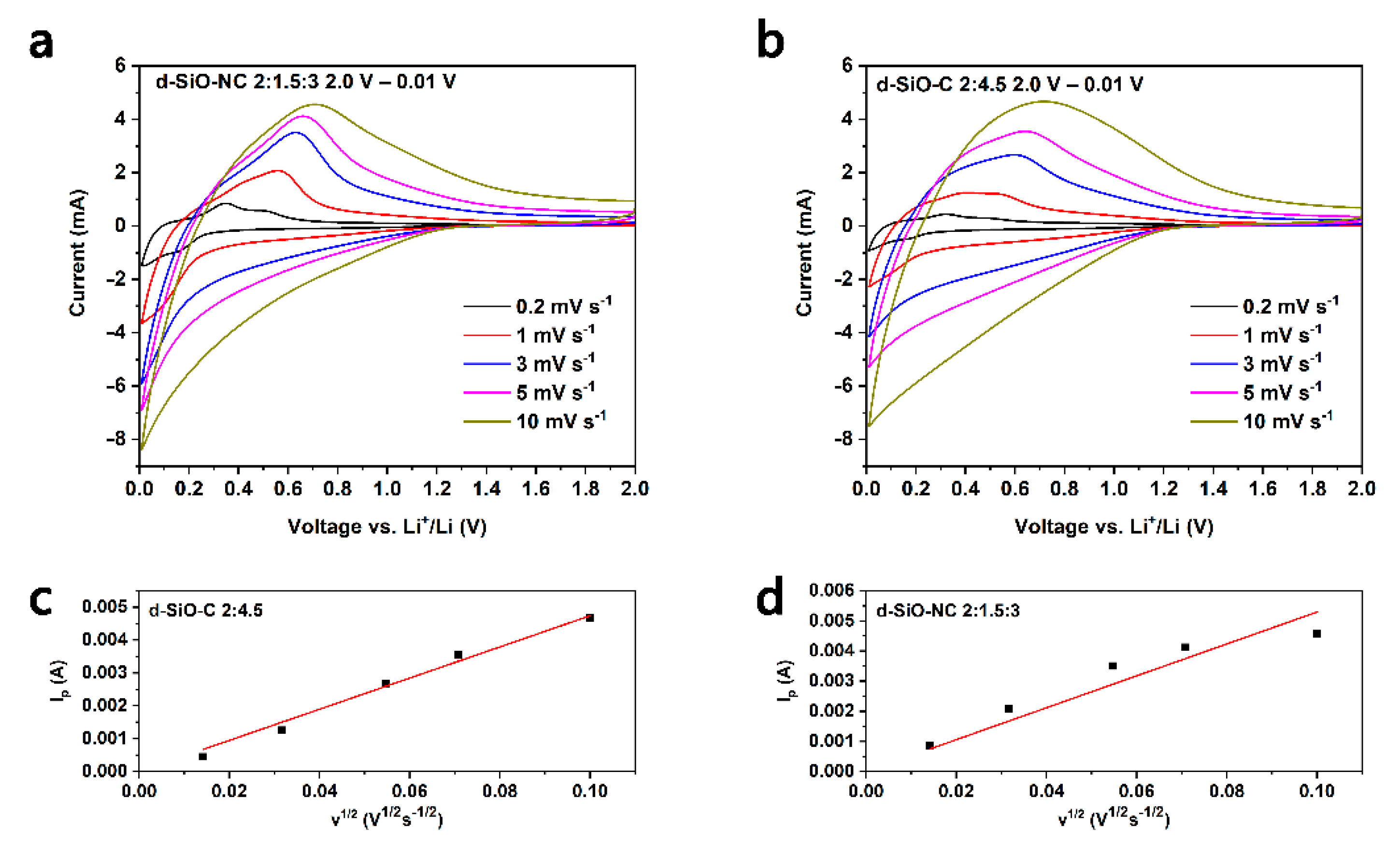
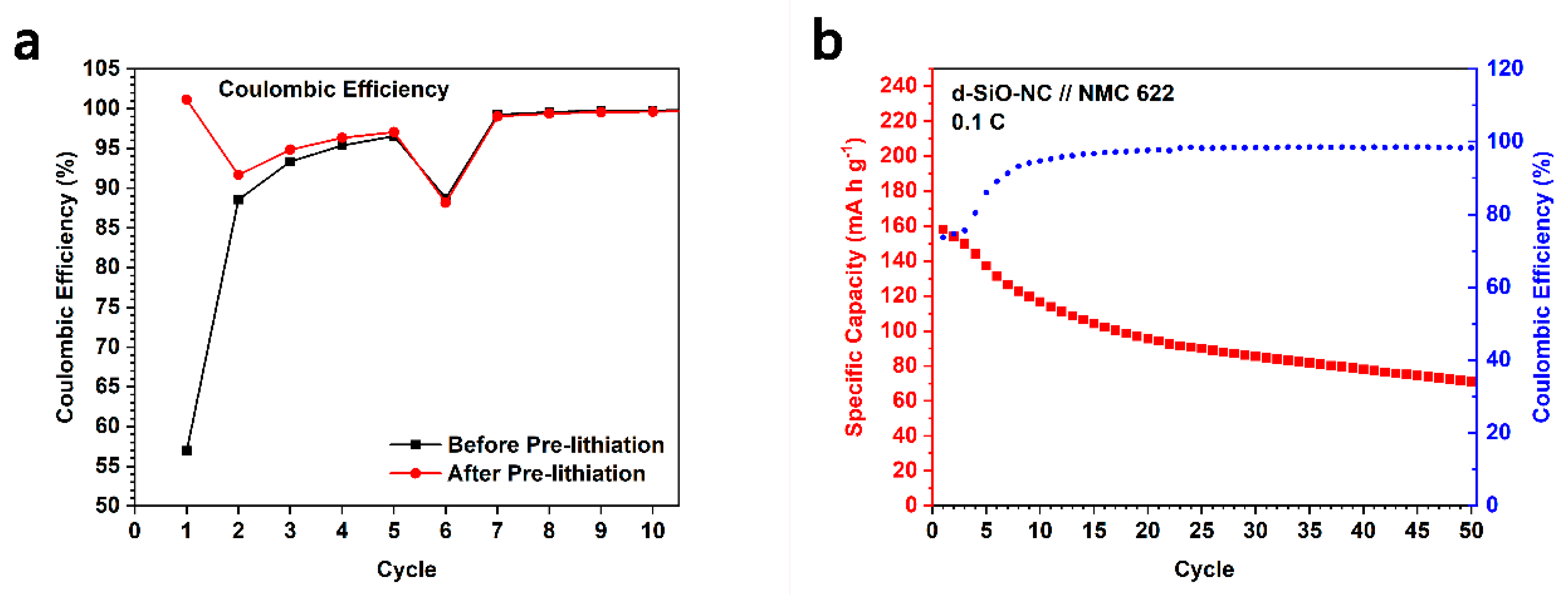
| d-SiO:Melamine:Pitch | d-SiO Content | N Content | C Content |
|---|---|---|---|
| 2:1:2 | 57.43% | 4.73% | 37.84% |
| 2:1.5:3 | 46.88% | 5.89% | 47.13% |
| 2:2:4 | 38.02% | 6.89% | 55.09% |
| Sample | Conditions | Rs (Ω) | Rf (Ω) | Rct (Ω) |
|---|---|---|---|---|
| d-SiO-C (2:4.5) | Before cycle | 2.269 | 285.3 | ~0 |
| After 5th cycles | 2.097 | 20.03 | 49.39 | |
| After 50th cycles | 3.549 | 17.12 | 45.50 | |
| d-SiO-NC (2:1.5:3) | Before cycle | 2.181 | 243.2 | ~0 |
| After 5th cycles | 2.18 | 12.62 | 21.15 | |
| After 50th cycles | 2.40 | 12.81 | 13.12 |
| Cells | Conditions | σW (Ω cm2 s−0.5) | DLi+ (cm2 s−1) |
|---|---|---|---|
| d-SiO-C//Li | Before cycling | 200.8 | 1.72 × 10−16 |
| After the 5th cycle | 304.42 | 7.48 × 10−17 | |
| After the 50th cycle | 219.3 | 1.44 × 10−16 | |
| d-SiO-NC//Li | Before cycling | 153.31 | 3.47 × 10−16 |
| After the 5th cycle | 218.77 | 1.70 × 10−16 | |
| After the 50th cycle | 186.46 | 2.35 × 10−16 |
Publisher’s Note: MDPI stays neutral with regard to jurisdictional claims in published maps and institutional affiliations. |
© 2021 by the authors. Licensee MDPI, Basel, Switzerland. This article is an open access article distributed under the terms and conditions of the Creative Commons Attribution (CC BY) license (http://creativecommons.org/licenses/by/4.0/).
Share and Cite
Huang, B.; Chu, B.; Huang, T.; Yu, A. Nitrogen-Doped Carbon-Coating Disproportionated SiO Materials as Long Cycling Stable Anode for Lithium Ion Batteries. Molecules 2021, 26, 1536. https://doi.org/10.3390/molecules26061536
Huang B, Chu B, Huang T, Yu A. Nitrogen-Doped Carbon-Coating Disproportionated SiO Materials as Long Cycling Stable Anode for Lithium Ion Batteries. Molecules. 2021; 26(6):1536. https://doi.org/10.3390/molecules26061536
Chicago/Turabian StyleHuang, Ben, Binbin Chu, Tao Huang, and Aishui Yu. 2021. "Nitrogen-Doped Carbon-Coating Disproportionated SiO Materials as Long Cycling Stable Anode for Lithium Ion Batteries" Molecules 26, no. 6: 1536. https://doi.org/10.3390/molecules26061536
APA StyleHuang, B., Chu, B., Huang, T., & Yu, A. (2021). Nitrogen-Doped Carbon-Coating Disproportionated SiO Materials as Long Cycling Stable Anode for Lithium Ion Batteries. Molecules, 26(6), 1536. https://doi.org/10.3390/molecules26061536






